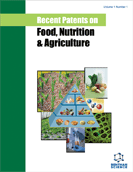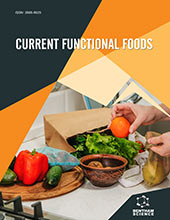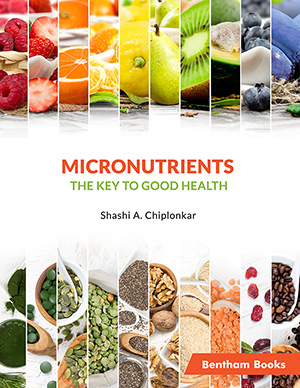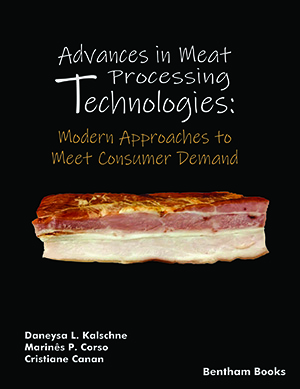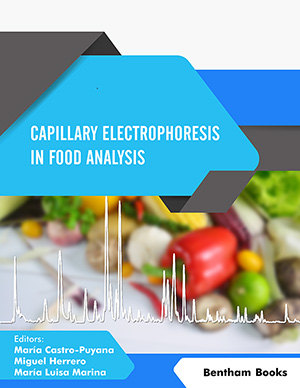Preface
Page: i-i (1)
Author: Seyed Mohammad Nabavi and Ana Sanches Silva
DOI: 10.2174/9789811446139120010001
List of Contributors
Page: ii-iv (3)
Author: Seyed Mohammad Nabavi and Ana Sanches Silva
DOI: 10.2174/9789811446139120010002
Dedication
Page: v-v (1)
Author: Seyed Mohammad Nabavi and Ana Sanches Silva
DOI: 10.2174/9789811446139120010003
Historical Background of Food Additives, Their Advantages and Drawbacks
Page: 1-17 (17)
Author: Shafaq Asif, Muhammed Bule, Fazlullah Khan and Kamal Niaz
DOI: 10.2174/9789811446139120010004
PDF Price: $30
Abstract
Food additives have been used since primordial times. They are the most important to impart artificial flavors and improve the quality of food and drinks. The earliest record in the history of adding additives to food dates back to Ancient Egyptian papyri circa 1500 BC. Food additives are added to food during preparation, processing manufacturing, treatment or packaging to modify chemical, biological, sensory or physical characteristics, and most of them do not have any nutritional value. They play a very important role as colorants, preservatives, antioxidants, acidity regulators, thickeners, stabilizers, emulsifiers, anti-caking agents and flavor enhancers. In addition, the demand of food additives in the food processing industries has sharply increased due to consumers’ preferences and commercial advantage they provide to the manufactured food because of longer shelf-life, standardized composition and convenience in processing. Dietary fibers play a vital role in weight management, diabetes, immune regulation, promoting dental health, colonic health, cardiovascular disease prevention and functions as dietary fiber and also support digestion in both animals and human beings. On the other hand, the use of food additives has been criticized for multiple health impacts such as cancer, asthma, allergies, and behavioral disorders in children. Therefore, regulatory authorities and law enforcement agencies have passed strict laws regarding food additives' approval and control. Nevertheless, in the last few decades, the food science and technology has swiftly advanced, resulting in an increased number and variety of food additives. Moreover, the quality and safety of food additives have developed as well.
Human Health Implications of Specific Group of Food Additives
Page: 18-36 (19)
Author: Maria Concetta Tenuta and Mariarosaria Leporini
DOI: 10.2174/9789811446139120010005
PDF Price: $30
Abstract
Additives are added to food in order to stabilize or increase the nutritional quality and quality and/or safety of the food matrix. Moreover, additives have a technological function and could improve the sensory properties of food.
For a long time, synthetic food additives are largely applied in food industries. Since the last year, there has been a decrease in chemical additives which are less welcome by consumers who prefer the use of additives from a natural source. In this chapter, several groups of additives are described such as antimicrobials, antioxidants and antibrowning agents, with colouring and flavouring agents.Anti-Browning Agents
Page: 37-60 (24)
Author: Faiza Mumtaz, Fazlullah Khan and Kamal Niaz
DOI: 10.2174/9789811446139120010006
PDF Price: $30
Abstract
Browning of food is a major concern in the food industry. The endogenous polyphenol oxidases (PPOs) are responsible for causing enzymatic browning of freshcut fruits and vegetables. The use of sulfites has been replaced by anti-browning agents due to the consumer awareness about potential adverse events and increased regulatory scrutiny associated with the use of sulfites. The objective of this study was to shed light on the potential role of different antibrowning agents to extend the shelf life and maintain the quality of fresh-cut fruits and vegetables. The antibrowning capacity is measured by calculating the reduced browning reaction of the cut surfaces and, retaining total visual quality. These agents can reduce cut surface browning through their potential mechanisms by acting as acidulants, chelating agents, complexing agents, enzyme inhibitors or reducing agents. Anti-browning agents can be used alone or in combination with either other agents or with other physical methods to control browning reaction.
Antioxidant Food Additives
Page: 61-81 (21)
Author: Ilias Marmouzi, Shahira M. Ezzat, Mourad Kharbach and Abdelhakim Bouyahya
DOI: 10.2174/9789811446139120010007
PDF Price: $30
Abstract
Food additives, especially antioxidant preservatives, are key elements in the food industry and production. Food antioxidants can be natural products such as extracts and purified natural metabolites, or synthetic compounds. They act as radical scavengers, chelators, quenchers, or antioxidant regenerators. Generally, food antioxidants target the preservation of food without altering its taste and colour. Synthetic antioxidants are cheap, easy to use and efficient as preservative agents; however, consumers tend to seek natural antioxidants. This chapter focuses on the different functional antioxidants such as polyphenols, tocopherols that can be used as food additives. These compounds are characterized by different chemical structures and different mechanisms of actions.
Antimicrobial Agents
Page: 82-103 (22)
Author: Ovais Sideeq, Fazlullah Khan and Kamal Niaz*
DOI: 10.2174/9789811446139120010008
PDF Price: $30
Abstract
Antimicrobial agents have been the target of numerous research studies for a long period of history and they still attract great research interest namely in what regards to the discovery of newer molecules or the search for newer sources of natural antimicrobials. Antimicrobial agents include drugs, supplements, and ointments which particularly act on bacteria, fungi, comprising molds and yeasts, viruses as well as parasites. Phytochemicals, essential oils, antimicrobial peptides, metal oxides like silver and gold, namely those found as nanoparticles, are being used to treat microbial infections. Antimicrobial pesticides, some of which are isolated from the bacteria themselves, are being studied to help eradicate pathogens in the clinic as well as being used by agricultural companies. There are also various food derivatives that are used as antimicrobial agents. In this chapter, antibacterial, antifungal, antiviral, and antiparasitic antimicrobial agents, which include natural and synthesized molecules used as food additives, are addressed. An outlook of recent advances in drugs and other procedures of treating microbial infections is also given. This chapter also focuses on antimicrobial essential oils and antimicrobial pesticides with a closer look at the effects of heat and radiation as antimicrobial therapies.
Essential Oils
Page: 104-119 (16)
Author: Regiane Ribeiro-Santos, Mariana Andrade and Ana Sanches-Silva
DOI: 10.2174/9789811446139120010009
PDF Price: $30
Abstract
Essential oils are natural compounds obtained from plants with powerful biological activities. Several studies have reported their use as food additives due to their actions as antimicrobial and antioxidant agents. Despite some limitations, such as aroma and toxicity related to high doses, the use of essential oils in foods is promising and makes it possible to reduce the use of synthetic additives in food applications. In this chapter, the most common extraction methods, as well as the antioxidant and antimicrobial activities of some essential oils are addressed. The legal aspects and the general health effects of essential oils are also covered.
Colouring Agents
Page: 120-153 (34)
Author: Natália Martins and Isabel C.F.R. Ferreira
DOI: 10.2174/9789811446139120010010
PDF Price: $30
Abstract
The world of food colorants has experienced a very exciting development in the last few years. The demand for increasingly organoleptic appealing, a safer, secure and healthy foodstuff is evident for consumers. Among them, the health-promoting ability of food products containing colouring agents is considered the most important. Linked with this, natural food colorants have been proposed as the most promising and safe alternatives. Numerous side effects and related toxicity have been increasingly associated with the consumption of synthetic colorants, some being already forbidden, while for others, the adequate daily intake (ADI) was re-adjusted. Thus, the aim of the present chapter is to provide an overview on the field of food colouring agents, namely highlighting the currently available natural and synthetic sources of colouring agents, the main representative groups and corresponding physicochemical properties, legislation and regulatory practices, and finally the latest pharmacokinetic data.
Phenolic compounds, including anthocyanins, carotenoids, and betalains, comprise the most commonly used food colouring agents from natural origin. At the same time, increasingly strict regulatory practices have been applied for the quality assurance of those from natural and synthetic origins. Naturally-derived food colorants seem to have higher quality and efficiency than those from synthetic sources, apart from playing a significant role as health promoters. Concerning synthetic food colorants, due to the increase in the reported side effects and toxicity, they have been progressively substituted by those obtained from natural origin. Allergic reactions, behavioral and neurocognitive effects are among the most frequent side effects, both at medium and long-terms. Overall, a marked change in attitude and priorities has been observed in consumers, not only related to food and nutrition science, but also pharmaceutical, nutraceutical and cosmetic industries. It drives manufacturers to find new, natural and healthy sources of colors and flavors and other organoleptic attributes for the currently marketed food products.Flavour Enhancers
Page: 154-172 (19)
Author: Mahalingam Jeyakumar and Kasi Pandima Devi
DOI: 10.2174/9789811446139120010011
PDF Price: $30
Abstract
Food flavors are chemicals that are added to food to enhance their smell and taste. Many of the food additives used by the food industries occur naturally in food that people consume each day. The flavors used by our ancestors were mostly isolated from the natural sources; however, since there was only limited supply, the food industries started using nature-identical and synthetic flavors as an alternative to the natural one. The sodium salt of glutamic acid, which is called Monosodium glutamate (MSG) is a flavor enhancer found naturally in tomato, parmesan cheese, and sardines in significant quantities and it is also produced synthetically. The synthetically produced MSG is one of the best food flavour enhancers used in many types of foods in the world, which are added during the different stages of foods for improving the taste, smell and shelf life. Though many flavor enhancers or food potentiators are considered to be safe, they are voluntarily discontinued to be used in baby foods, as a precaution. The current review discusses the types, uses and properties of the flavor enhancers commonly used in foods.
Flavors (Including Umami Ingredients of Edible Mushrooms)
Page: 173-190 (18)
Author: Raees Khan*, Faiz-ur- Rahman, Shehzad Mehmood, Saima Ali, Sheikh Zain Ul Abidin, Abdul Samad Mumtaz, Ejaz Aziz, Riffat Batool, Hussain Badshah and Ömer Kiliç
DOI: 10.2174/9789811446139120010012
PDF Price: $30
Abstract
Flavor is among the most essential factor for food selection and determines the taste, trigeminal and aroma of the food item. Currently, five main types of flavors are recognized i.e. sweet, sour, bitter, salty and umami. Umami flavor has a pleasant savory taste and is becoming popular in the food industry for the enhancement of food taste. Edible mushrooms are one of the major sources of umami flavor. Similarly different natural and synthetic flavorings and flavorants are added to enhance food products. These flavorings and flavorants also have health benefits and apprehensions to human health. The natural plant-based flavor products should be encouraged as they have health benefits and are being used for thousands of years as flavorings & flavorants and as traditional plant-based medicines. The food industry is looking for new plant-based flavoring agents to satisfy consumer demands.
Sweeteners
Page: 191-211 (21)
Author: Francesca Aiello
DOI: 10.2174/9789811446139120010013
PDF Price: $30
Abstract
A sweetener is a molecule that gives a food, or a drink, a sweet taste, thus activating the areas of taste used to perceive this as flavor. Sweeteners, as they increase the palatability of food, are widely used in the production, including industrial, of foodstuffs. In this regard, it is a common practice to add quantities of sugar to the recipes in order to gain consensus on the food market, since the sweetest products are most welcome among consumers. The need to use sweeteners has increased significantly in recent decades, due to the increased sensitivity to problems caused by excess sucrose (the common kitchen sugar) in human nutrition. It is clear that a diet rich in sugars, which exceeds 5% of daily caloric needs, can lead to very important pathologies ranging from common caries to diabetes. For this reason, it is preferred to adopt different “safer” solutions. In this chapter, the most commonly used sweeteners have been described, highlighting their chemical structure, their safe amount, and utilizable and toxic effects, where applicable. To guarantee an easy reading, the chapter includes three categories, natural sweeteners, sugar alcohols and intense sweeteners, which collect all the similar sweeteners.
Emulsifiers
Page: 212-232 (21)
Author: Devasahayam Jaya Balan and Kasi Pandima Devi
DOI: 10.2174/9789811446139120010014
PDF Price: $30
Abstract
Emulsifiers are high molecular weight surface-active agents that facilitate the formation and stabilization of emulsions. They are used in food products to obtain uniform quality with improved texture and long shelf life. They are commonly found in packaged and prepared foods, such as baked goods, soft drinks, candies, gums, whipped creams, biscuits, breads, ice creams and margarines. Emulsifiers, in food products, allow uniform blending by reducing the interfacial tension between different phases like water, oil and gases. Their wide applications have established the presence of emulsifiers in nearly all food products and have also advanced the food processing techniques. However, the stability of emulsifiers can be affected by the salt content and pH variations in food emulsions. Emulsifiers, produced by biological systems, such as microorganisms and yeast, are called bio-emulsifiers which are also used in various food products. The synthetic emulsifiers pass through the body without being metabolized, whereas naturally occurring molecules are metabolized in the body. Worldwide, about 500,000 metric tons of emulsifiers are produced and sold. The legislation on emulsifiers governs their safety assessment, authorisation, use and labelling. The food legislation community aims to establish the right balance between the risks and benefits of substances that are used intentionally and to reduce the contaminants in accordance with consumer protection. In the food industry, many emulsifiers are used without any evidence of harmful effects that were confirmed by various safety analyses. The current review focuses on the food emulsifiers which play an indispensable role in the production of food products with the highest quality.
Stabilizers (Including pH Control Agents and Phosphates)
Page: 233-245 (13)
Author: Tarun Belwal, Hari Prasad Devkota, Ankur Kumar Goel and Indra D. Bhatt
DOI: 10.2174/9789811446139120010015
PDF Price: $30
Abstract
The continuous availability of food, as a very basic requirement of life, has always been a difficult aspect due to food contamination and decomposition. It is a difficult task for food scientists to make food products available in good condition after harvest and/or processing, storage and transportation to other places from their place of origin. The use of food additives allows food products to maintain their quality during storage as well as improve shelf-life and maintain their palatability and nutritional quality. The role of stabilizers as food additives is becoming crucial in controlling the pH of the product as well as stabilizing the product texture and its structure. These stabilizers are becoming more popular and widely used in various food products and are chosen based on different criteria. Their origin, either natural or synthetic, is one of the most important criteria regarding consumer acceptability. Various physiological and toxicological profiles of these stabilizers have also been studied. This chapter describes the general aspects of food stabilizers and their application in various food products. Further research is necessary to widen their applications and consumer acceptability as well as to determine possible toxicological effects.
Indirect Additives
Page: 246-268 (23)
Author: Mariana A. Andrade, Regiane Ribeiro-Santos, Seyed M. Nabavi and Ana Sanches-Silva
DOI: 10.2174/9789811446139120010016
PDF Price: $30
Abstract
Indirect food additives are the additives that are not intended to be added directly to foods but are added to food contact articles namely, food packaging. In this chapter, the main indirect additives are reviewed, as well as, the legal aspects and regulatory control applied to these kinds of substances in the USA and the European Union. The migration of some of these compounds to foods is undesired and, in some cases, may represent a threat to human health. This chapter also highlights some specific groups of indirect additives including monomers, plasticizers, antioxidants and antimicrobials, catalysts, initiators, curing and cross-linking agents, stabilizers, and solvents. Future trends in the use of indirect additives are also discussed in this chapter. Innovative technologies in the food packaging industry are emerging every day, so the regulations and the regulatory agencies must be updated.
Relation of Food Additives with Adverse Health Effects
Page: 269-283 (15)
Author: Devesh Tewari, Pooja Patni, Sweta Bawari and Archana N. Sah
DOI: 10.2174/9789811446139120010017
PDF Price: $30
Abstract
Food additives are widely used by the food industries for attracting a larger number of consumers by making the food more appealing. Some of the food additives which are used by the food industries are bulking agents, emulsifiers, food colorants, flavoring agents, preservatives, and sweeteners. Despite the beneficial effects of food additives, these additives can also cause serious adverse effects on humans. Some of the most common adverse events include anaphylaxis, asthma, urticaria and/or angioedema. In this chapter, we describe the adverse health events that are caused as a result of different food additives with special reference to allergic, immunologic reactions, asthma, autoimmune diseases, cancer, diabetes and metabolic disorders. Although the animal and in vitro studies that examined the adverse health effects of different food additives are available, the clinical studies which examined the adverse health effects of different food additives in a large population group are very limited.
Membranes and Membrane Operations in Functional Food Production
Page: 284-312 (29)
Author: Carmela Conidi, Francesco Galiano, Alfredo Cassano and Alberto Figoli
DOI: 10.2174/9789811446139120010018
PDF Price: $30
Abstract
This chapter focuses on the recent advances in the use of membrane processes for the recovery of biologically active compounds (BACs) from agro-food products and by-products. The fundamentals of typical membrane operations, as well as of membrane preparation, are firstly presented. Then, typical case studies for the recovery of polyphenols, peptides, carotenoids and tocopherols are presented and discussed. Multistep membrane processes for the separation, purification and concentration of BACs from their original sources are specifically designed based on laboratory experimental data. These processes provide concentrated fractions for the formulation of functional foods within a biorefinery strategy, with significant economic and environmental advantages over conventional methodologies.
Controversies Regarding Food Additives and Future Trends
Page: 313-323 (11)
Author: Ana Sanches Silva, Dalia Sánchez-Machado, Jaime López-Cervantes and Seyed M. Nabavi
DOI: 10.2174/9789811446139120010019
PDF Price: $30
Abstract
Nowadays food additives are far more than just salt, vinegar, herbs and spices. These compounds are essential to preserve and enhance the original characteristics of foods in order to make them more appealing, nutritious, safe, convenient and affordable. They also have an outstanding role in the production of greater quantities of food with high- quality standards and in the obtainment of food to promote well-being and health. This chapter focuses on the main controversies of food additives, namely the duality between natural and synthetic antioxidants and provides insight into their future trends. Although natural additives are generally preferred, they can also present drawbacks such as low availability, high price, low potency, low food compatibility and difficulty to predict the effect due to their multiple activities. In fact, new food processing technologies are expected to slow down food additives use, but, on the other hand, new additives, will replace the current ones in order to improve the characteristics of foods, increase food safety and improve the health and well-being of consumers.
Subject Index
Page: 324-336 (13)
Author: Seyed Mohammad Nabavi and Ana Sanches Silva
DOI: 10.2174/9789811446139120010020
Introduction
INTRODUCTION This reference is a detailed guide to the world of food additives commonly used in the food processing and manufacturing industry. Edited by experts in the field, invited scholars enrich the book with relevant chapter contributions. Chapters provide readers with knowledge on a broad range of food additives (anti-browning agents, essential oils, flavour enhancers, preservatives, stabilizers, sweeteners, among others), their safe use and a summary of their effects on human health. Key Features: - Covers a wide range of natural and synthetic food additives - Covers health related topics relevant to food additives - Chapters are organized into specific, easy-to-read topics - Provides bibliographic references for further reading This book serves a valuable instrument for a broad spectrum of readers: researchers, health professionals, students, food science enthusiasts, and working professionals in industry and government regulatory agencies interested in the science of food additives.



